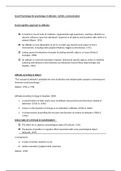Social Psychology the psychology of attitudes , beliefs, communication
Social cognitive approach to attitudes
A mental or neural state of readiness, organised through experience, exerting a directive or
dynamic influence upon the individual’s response to all objects and situations with which it is
related (Allport, 1935)
An attitude is a pre-disposition to act in a certain way toward some aspect of one’s
environment, including other people (Mednick, Higgins & Kirschenbar, 1975)
Lasting, general evaluations of people (including oneself), objects, or issues (Petty &
Cacioppo, 1986)
An attitude is a learned evaluative response, directed at specific objects, which is relatively
enduring and influences and motivates our behaviour toward these objects (Eagly and
Chaiken, 1993)
Attitude according to Allport
“The concept of attitude is probably the most distinctive and indispensable concept in contemporary
American social psychology.”
(Allport, 1935, p. 978)
Attitude according to Hogg & Vaughan, 2005)
1. A concentration on fairly static issues of attitude measurement and how these related to
behaviour (1920s & 1930s)
2. A focus on the dynamics of change in an individual’s attitudes (1950s & 1960s)
3. A swing towards unravelling the structure and function of systems of attitudes (1980s &
1990s)
STRUCTURE OF ATTITUDE IN COMPONENTS –
The affect for or against a psychological object (Thurstone, 1931)
The degree of positive or negative affect associated with some psychological object
(Edwards, 1957)
2 components
a) A state of mental readiness to act
b) Guides evaluative (judgemental) responses
(Allport, 1935)





